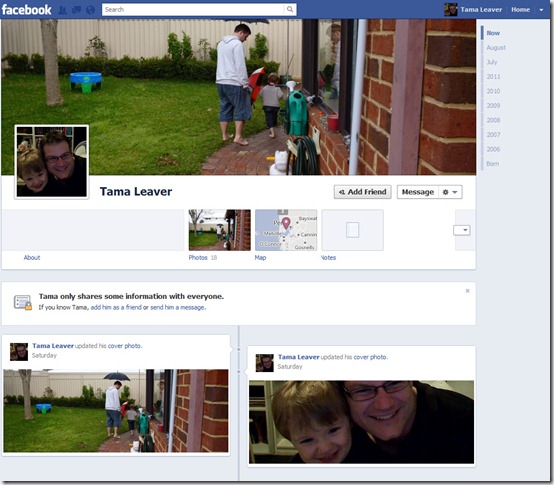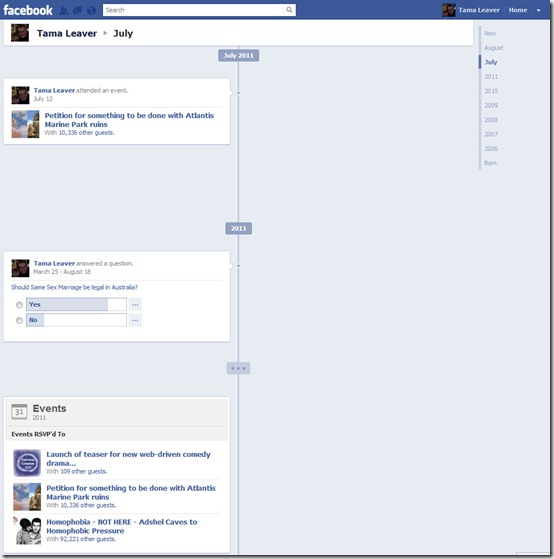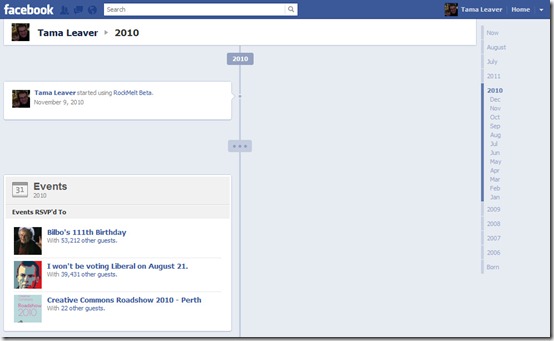Home » Posts tagged 'timeline'
Tag Archives: timeline
Facebook’s New Timeline & Perceptions of Privacy
Everyone’s Facebook profile will disappear in 6 October 2011, December 2011 replaced with a Timeline. Here are my thoughts and concerns about that Timeline, and some suggestions about managing your Timeline when it arrives …
I’ve been testing out Facebook’s new Timeline which will shortly replace profiles for all 800 million Facebook users. I have some concerns which I’ll outline in a minute, but I have to give credit where credit is due: Timeline looks amazing. I think this is the first time Facebook has stopped looking like a direct descendant of the profiles found on online dating websites! The new cover image, which is separate from your avatar or profile picture, stretches across the entire screen and is much more richly visual experience, combined with far better navigation tools for exploring the entirety of someone’s Facebook history, not just their current statuses and photos. Here’s what the top of my Timeline looks like:
The tools which allow you to emphasise certain events on your timeline let individuals build an engaging and carefully curated story of themselves. And in a move which deliberately situates Facebook as telling the story of your life, Timeline actively encourages users to add in missing details. When I look at the notification of my 2000 university graduation, Timeline suggests I add to the story and post a picture, enriching the tale visually. If I add a picture, then the event ‘looks’ more interesting and is more engaging than a bit of text in an ‘Info’ box. However, in moving from being primarily about current communication to adding the archival/historical emphasis, a number of privacy-related issues arise.
My Timeline image above is missing a lot of detail since it’s the view that the public can see – ie someone who I’m not connecting to at all – and my privacy settings are high (almost everything is ‘Friends Only’; incidentally, once your Timeline is visible you can use the right-hand setting indicator – the one that looks like a wheel – and select ‘View as …’ to check how your Timeline will look to anyone else, including the public view). It’s notable, then, that the cover photo — the big one, at the top of your Timeline, which isn’t your profile photo — joins your profile photo as an image that you can’t make private; if you can be found on Facebook, it’s there. (I presume this might disappear if you prevented your profile being found in searches, but I can’t say that definitively.) Profile pictures have been unavoidably public for a while, so we just need to remember this about cover photos, too.
If you scroll down my Timeline (which, as I said, is now absurdly easy with the right hand date-based navigation tools) this is what you can see for 2011 and 2010 (there’s not much there, but take a look at what is visible):
On some abstract level, I was aware that when I ‘voted’ or clicked ‘Attending’ I was committing to something that was visible beyond my immediate ‘friend’ network (notable for me since, due to my privacy settings, not much else is). However, most of these actions or events had, from my perspective, long since ‘disappeared’ to the extent that, in order to find them, someone would have to click to ‘load more’ on my Facebook profile page 20 times or more to see anything. Timeline changes that. Now my voting and the public events I attended are very prominent since that’s pretty much the only thing public. And while these were largely very quick responses, these little bits of information suddenly ‘say’ a great deal about me; indeed, for the public, these are the main bits of the story Facebook tells about me.
Now, some of the things I’ve said I’ve attended are pretty trivial, but some are political (it’s very clear what my political views are) and others are on the boundary of personal and political. When I voted ‘Yes’ to ‘Should Same Sex Marriage Be Legal In Australia’ I was stating something publicly, but I’d never considered that my response would be so prominent on Facebook (it wasn’t on my profile page very long, for example). Now, for me, this isn’t a big issue; I’ve got sufficient workplace security that I can’t imagine these views would jeopardise my employment, and I stand by my politics proudly. I suspect, though, this won’t be the case for everyone. I can think of numerous scenarios where this information might be misused by other people and I strongly recommend folks take a look at their Timeline view from the public perspective as soon as it’s available to them.
From what I can see, it is possible to remove certain items from Timeline, or at least reduce their prominence, but you have to do it from your view (not the public view I used to generate the above images) so if you’re a prolific Facebook user, it’ll take a while to find these items and reduce their visibility.
Now, I’m not suggesting Facebook ‘made public’ something that was private. This information may have felt private, but that was based on use, not on a technical sense of security. Indeed, danah boyd expressed this problem in her paper ‘Facebook’s Privacy Trainwreck: Exposure, Invasion, and Social Convergence’ explaining:
The tech world has a tendency to view the concept of ‘private’ as a single bit that is either 0 or 1. Data are either exposed or not. When companies make a decision to make data visible in a more ‘efficient’ manner, it is often startling, prompting users to speak of a disruption of ‘privacy’.
Technically, the information above was always public, but my experience of it meant it felt largely private. My example is extremely banal, but for other people, the sudden prominence of certain information may make it feel a lot more public than they ever intended. While I acknowledge Facebook has started to provide more robust privacy tools, I’ve seen nothing in the hype around Timeline to warn folks about the way their Timeline will tell a different story about them (and a different story to different people – your Friends will see one ‘you’, but the public may see a quite different one). If Facebook is going to be an ongoing repository, the always-being-edited ‘This Is Your Life’, then Facebook and those of us teaching about these tools need to ensure folks have a much better understanding about Timeline and similar changes. When your life story is a series of entries in a database, then the line between public and private is a single setting. However, that database, as we can see, can always be sorted, ordered and presented in very different ways.
Annotated Digital Culture Links: March 6th 2009
Links for February 26th 2009 through March 6th 2009:
- Australians spend much more time online | Australian IT – “The Nielsen Online Internet and Technology Report surveyed more than 2000 Australians and found the average Aussie spent 89.2 hours a week consuming media last year or almost 80 per cent of their waking hours. … this was an increase of almost five hours on 2007 and an extra 17.8 hours from 2006. “Given the average Australian is only awake for around 112 hours per week, it’s surprisingly just how many of those waking hours are dedicated to media consumption… We’ve seen some pretty extraordinary increases in the past few years, however we would anticipate a levelling out in consumption hours of the next few years as Australians simply run out of hours in the day.” … people aged over 16 spent an average of 16.1 hours on the internet each week, 12.9 hours watching TV, 8.8 hours listening to the radio, 3.7 hours on a mobile phone and 2.8 hours reading newspapers. Some users also used more than one form of media at once, with more than three in five internet surfers [also]watching TV”
- RED MARS For Free [Warren Ellis] – “Kim Stanley Robinson’s brilliant sf novel RED MARS is now available as a free PDF download from its US publisher. [Direct link to PDF], and their Free Library page listing it and other available free downloads. Be warned: RED MARS is first of a trilogy, and there’s a good chance you’ll find yourself craving the others (GREEN MARS and BLUE MARS).” (If you”ve not read Red Mars, you’ve missed out on the best hard SF in years, go read it. As Ellis says, once you’ve gone Red, you won’t be able to stop yourself rushing to buy Green and Blue, too!)
- Virtual Worlds – Detailed timeline of the emergence of Virtual Worlds – encompasses many recognisable and a few more abstract elements (do virtual worlds really start in the 1700s?) (Thanks, Jill)
- Web censorship plan heads towards a dead end [The Age] – “The Government’s plan to introduce mandatory internet censorship has effectively been scuttled, following an independent senator’s decision to join the Greens and Opposition in blocking any legislation required to get the scheme started. The Opposition’s communications spokesman Nick Minchin has this week obtained independent legal advice saying that if the Government is to pursue a mandatory filtering regime “legislation of some sort will almost certainly be required”. Senator Nick Xenophon previously indicated he may support a filter that blocks online gambling websites but in a phone interview today he withdrew all support, saying “the more evidence that’s come out, the more questions there are on this”. The Communications Minister, Stephen Conroy, has consistently ignored advice from a host of technical experts saying the filters would slow the internet, block legitimate sites, be easily bypassed and fall short of capturing all of the nasty content available online.”
LOLtimez – Internet Meme Timeline
There have been a lot of memorable memes in the last decade, and this fantastic meme timeline captures almost all of them:
There are a few in there that are new to me, but everything up to 2005 is provoking flashbacks aplenty. Indeed, the first substantial blog post I ever made was about our old friend the Star Wars Kid! How many of these are familiar to you?



